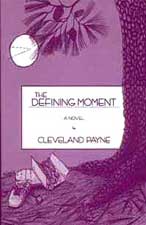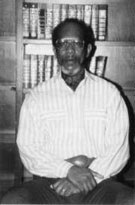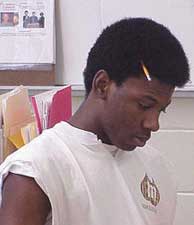Major Works
- The Long Drive (2008)
- The Silver Pendant (2006)
- The House on the Boulevard (2002) Novella
- The Defining Moment (2000) Wolf River Press.
- Laurel Remembrances (1996)
- The Road To San Antonio: The Journey of Career Airman Johnnie T. Hearn (1995)
- From Kemper To California: The Long Journey (1992)
- Laurel: A History of a Black Community 1882-1962 (1990) (Privately printed)
- The Oak Park Story: A Cultural History (1988)
Cleveland Payne: A Biography
by Tony Lucious (SHS)
Cleveland “Troller” Payne is a long time Laurelite and a 1957 graduate of the Oak Park Vocational High school in Laurel, Mississippi. He was a star athlete while at Oak Park and later was inducted in the Oak Park Hall of Fame. Payne’s college background includes degrees from Rust College, Delta State College, and the University of Southern Mississippi. He went to Rust College in 1959 but did not finish within a four-year period because of financial problems. Payne wasn’t satisfied without achieving his goal, so he was determined to go back.
While at Rust College, Payne majored in social sciences, but his talent for writing was discovered by his English instructor, Mr. Thomas Bibbs. Payne was assigned to write a narrative about romance in Bibb’s history class. He entitled the narrative A letter, A Beach, and a Girl Named Grace. His instructor encouraged him to pursue a career in journalism and write as much as possible. Payne enjoyed writing; but with his busy schedule as a basketball player and track star, there was little time to pursue his interests. He had a wide range of interests but eventually discovered a great affinity for history and research. Taking Bibb’s advice, in his last year of college, Payne added more English courses to his schedule to improve his writing skills. That same year, while practice teaching at W.T. Sims High School, he was told by his supervising teacher to prepare a project to present before Rust College. Payne decided to base his project on William Saroyan’s acclaimed short play Hello Out There. His presentation earned rave reviews from the critics and again his writing skills earned him high recognition.
When graduation came from Rust College, Payne journeyed back to his hometown of Laurel where he taught a social studies class in the public school. Later he enrolled at the University of Southern Mississippi where he would again put his creative writing skills to use. In 1982 he became the first student to earn a specialist in history at Southern Mississippi in the new degree program. Payne’s journey as an author started to take shape while he was completing his graduate work at Southern Mississippi. His thesis Laurel: A History of the Black Community 1882-1962, was refined and published as his first book. Soon people discovered Payne’s writing skills, and he was asked to write The Oak Park Story. He also wrote a column called “Laurel Remembrances” for the Leader-Call newspaper. After reading the column, Payne’s managing editor suggested that he put his writings in a book. Surprisingly, Payne took the advice and Laurel Remembrances was published in book form in 1996. The book was said to bring to mind the German term “zeit geist,” which means ‘the spirit of time.’ Payne gained high recognition from critics and readers. He was said to have a style that would be great for a novel.
Payne later published The Defining Moment, which was his first novel. The book was published in 2000 and was submitted to the Oprah Winfrey Book Club. On February 14, 2000, his hometown of Laurel honored him with the Millennium Medallion in recognition of his lifelong commitment to illuminating the beauty of life in Laurel through his lyrical writings and memoirs. Payne is the author of five other books: The Oak Park Story: A Cultural History (1988), From Kemper to California: The Long Journey (1992), The Road to San Antonio: The Journey of a Career-Airman Johnnie T. Hearn (1995), and Laurel Remembrances (1996). All of these works are volumes which are fact based (Payne). Payne is currently working on a novel about the Spanish Civil War.
Reviews
A Review of The Defining Moment
by Tony Lucious (SHS)
 The Defining Moment, a novel by Mississippian Cleveland Payne, is an intriguing novel that tells the story of a young Richard (Slim) McCall and his struggles to find the source of his early disconnection with his stepfather and the strong presence of a fire-scarred, old woman named Gloria. The novel begins late evening in early May high on a hilltop in Jackson, Tennessee. A tall, frail Rust College runner named Slim McCall runs toward to a small cluster of pine trees on a hill north of the track field. It was there on that hilltop that the question came to him as it had so many times before. “Why did Jim hate me all these years, when he never cared what I thought or felt?” It was that moment that would change the path Slim’s life was taking.
The Defining Moment, a novel by Mississippian Cleveland Payne, is an intriguing novel that tells the story of a young Richard (Slim) McCall and his struggles to find the source of his early disconnection with his stepfather and the strong presence of a fire-scarred, old woman named Gloria. The novel begins late evening in early May high on a hilltop in Jackson, Tennessee. A tall, frail Rust College runner named Slim McCall runs toward to a small cluster of pine trees on a hill north of the track field. It was there on that hilltop that the question came to him as it had so many times before. “Why did Jim hate me all these years, when he never cared what I thought or felt?” It was that moment that would change the path Slim’s life was taking.
At this point the book flashes back to the meeting of Slim’s parents Edmond McCall and Paula Grayson. Paula and Ed met at a revival in Cuba. She was a strikingly tall, cream-colored woman with long hair and sparkling brown eyes. Ed was a medium-built construction worker from southeastern Kentucky. Also in attendance was a short compact, hardworking sharecropper named Jim Fulford. He was the oldest of five brothers, and he had made advances toward Paula for nearly a year. Watching the blossoming relationship between Paula and Ed made Jim angry, and he would have his revenge. Over the years, the anger started to build up inside of Jim. Years passed. Ed and Paula were married and had a son. They were now living back in Ed’s hometown with Ed’s twin sisters, Sara and Mary. Soon after Richard’s birth, Ed became ill with pneumonia and later died. This period is the period that Payne calls the “The Dark Cloud.” Traumatized by the death of their only brother, Sara and Mary soon follow him. Paula later moves back home and marries Jim Fulford to put her past behind her. Slim grows to resemble his mother more than his father. He was a very energetic kid who was loved by everyone. He was also helpful around the neighborhood and would do many side jobs, maintenance work, and deliver newspapers. Slim resented his stepfather and turned his resentment towards school, but he was an excellent student academically. I liked the book. You will need to read it yourself for the resolution.
A Review of The Oak Park Story
by Tony Lucious (SHS)
The Oak Park Story is a true history of a black school in Laurel, Mississippi, founded in 1882 when John Kamper, a wealthy contractor, built a mill to provide timber to complete the Northern and New Orleans Railroad. The work force for the construction was predominantly black. In 1891, the Eastman-Gardiner Company of Clinton, Iowa, purchased the Kamper Mill Properties. The enterprise consisted of baron-brothers, George and Silas Gardiner and brother-in-law Lauren C. Eastman. In 1893, another brother-in-law named Wallace joined the company. After the “critical period” had passed in 1896, the company seems to have had a favorable future. In 1897, Rogers started a weekly newspaper called The Laurel Chronicle. The Laurel Chronicle carried a column entitled “Progressive Colored Citizens,” which was the first white-owned newspaper in the state of Mississippi to highlight the contributions of black citizens in a positive way. The column encouraged blacks to come to the city of Laurel to work in the timber and railroad industries.
The population of Laurel grew rapidly; and in 1899, Laurel’s first public school was built. It began operating as an attendance center for whites. The following year the “Negro Education” provisions were completed by renting the “Odd Fellows Hall,” which was black owned. It soon came to be called “Laurel Colored Schools” marking the beginning of the black and white educational system in Laurel. Laurel’s population increased from 3,198 to 13,027 inhabitants – mostly in the black communities. In 1900, the “Colored School” had 43 students instructed by one teacher/principal. In 1920 the school consisted of 100 students taught by 18 teachers and supervised by two principals covering grades 1-8. It soon became clear that more buildings were needed to occupy the increasing enrollment of black students.
By the 1920’s Laurel had become the “number one industrial town in the state of Mississippi and was later called the “yellow pine ” capital of the world. Between 1920 and 1925, Laurel’s population grew 32 percent, and the school-aged population grew 27 percent. Laurel approached the 19,000 residents mark. Plans to solve overcrowding problems resulted in the St. Elmo Church Library Project, completed 1922 as Southside School. A second plan resulted in the building of the Southside School #2. This institution became the Sandy Gavin School and began operating in 1925. The project solved a smaller problem, but the black community was still in need of a high school. By 1925 there was on going confusion between the whites and the now well-defined black middle class. The interaction between the two, although there was disagreement, was always respectful. The two groups agreed first on the establishment of the Queensburg Academy for Colored Students. Queensburg was built in 1925, and later became Oak Park Vocational High school. The Oak Park Vocational High School, under the supervision and jurisdiction of the Laurel City School System, opened in September, 1928. Oak Park consisted of 325 students and 10 teachers. A board of trustees controlled the grounds on which the school was built. Funds were put aside for the school’s support system. J. E. Johnson became principal and was later assisted by J. H. Mosley (Oak Park Story 7-13).
An Interview with Cleveland Payne (2002)
by Tony Lucious (SHS)
“Who published The Oak Park Story?”
“In 1988 The Oak Park Story was published by Quail Ridge Press in Brandon, Mississippi.”
“Was The Defining Moment based on actual experiences?”
“The Defining Moment, I must admit is a book that “gutted” me. It basically follows my life journey up until 1965, but it also has the work of imagination, I had to create and invent characters as well as embellish; therefore, it had both fact and fiction, but it’s mostly factual. This book is cathartic. I had to reach deep down and come up with some truth of my existence. I’m very proud of what I was able to do in The Defining Moment.”
“What is your family background?”
“My family background is middle class/ rural/ small town.”
” Is Laurel Remembrances and Laurel: A History of the Black Community the same book?”
“No! Laurel Remembrances is a total of forty-one vignettes about a special place, special situation, and memories written mostly from personal perspective dealing with seasons, special people, theater and so forth. Laurel: A History of the Black Community is a work of history. The first half of it is a specialist thesis in history for a degree. It shows the rise of the black middle class in Laurel that was well defined by 1928. The second half deals with the impact of the Great Depression, World War I, and the Korean Conflict through the early 1960’s, the well-defined middle class was in 1962 merely a shadow.”
” Do you have any family in Starkville?”
“Yes! My daughter Estella with Social Security Office through a student program at East Mississippi Community College in West Point and the Triangular area, also the Ware family in Starkville, Mississippi are my in-laws.”
“What inspired you to become a writer/journalist?”
“I was inspired to become a writer as a result of a paper that I did at Rust College in 1964 on First Romance. The title was “A Letter, A Beach, and a Girl Named Grace.” The instructor read it in class and was touched. That’s when I first got the “bug”.”
“What advice do you offer to others?”
“My advice to others is live in the moment, see the beauty of people, and the world’s situations. It’s there! One must look for it. Read works about the human connections: Faulkner, Richard Wright, James Joyce and Walt Whitman.”
“How is it for a black writer in Mississippi?”
“A black writer in Mississippi has to go it alone because he is not given serious consideration, especially if he has a romantic beret; however, my writings were recognized by certain Laurelites as special so they have always bought my books. The black community supports my work because I’m a black writer, and also they buy them because I represent them.”
“What are your hobbies?”
“My hobbies include reading, running, and attending movies.”
“Are you married?”
“Yes. I’m married to Alice (Ware) Payne formerly of Starkville, Mississippi.”
“Do you have any children?”
“Yes. We have two children. Estella and Kenneth Victor Payne (formerly with the Philadelphia 76ers basketball team, now retired from pro sports).”
“What makes you different from other writers?”
“I think that as a novelist now I include the facts of history (being a historian) and the rhythm of the poet (being a romantic). I have high regard for human beings as they have tried to find their place in the world and relate positively to each other. I don’t know if I’m different.”
“What is the Millennium Medallion?”
“The Millennium Medallion was given to a few outstanding Laurelites in the year 1999 and 2000. Mine was for writing about the beauty of Laurel lyrically making people proud of their hometown. Once a mayor gave me a gold pin. He pinned it on me and said, ” I read all your work! You don’t trash Laurel.” This was not the Millennium Medallion, but the pin was and is still important to me.”
“How does it feel to a recipient of the Millennium Medallion?”
“Great to be given your hometown’s highest award.”‘
Related Websites
Bibliography
- “Payne, Cleveland.” The Defining Moment. Mississippi: Wolf River Press, 2000.
- “Payne, Cleveland.” The Oak Park Story. Mississippi: Quail Ridge Press, 1988.
- “Payne, Cleveland.” Letter to Tony Lucious. 12 April 2002. Private Collection. 1141 Yeates Subdivision.


